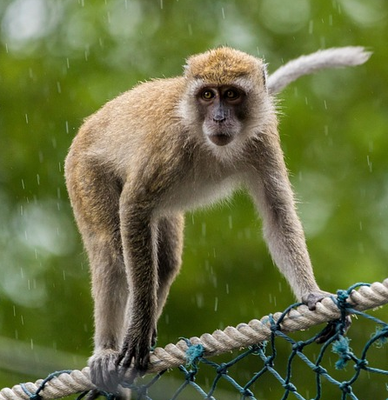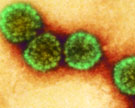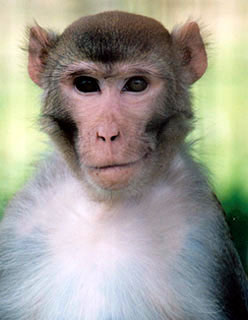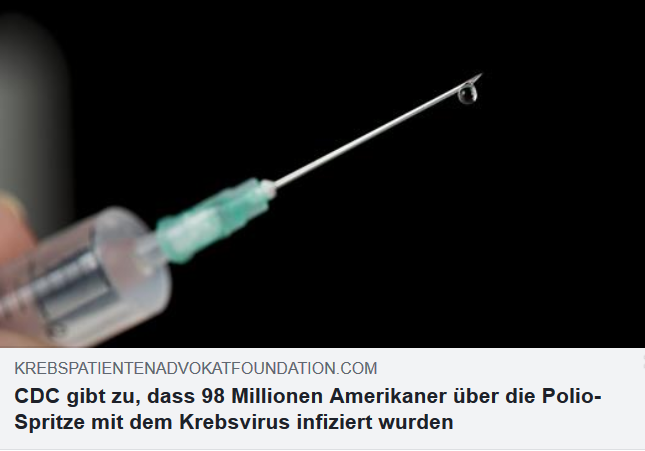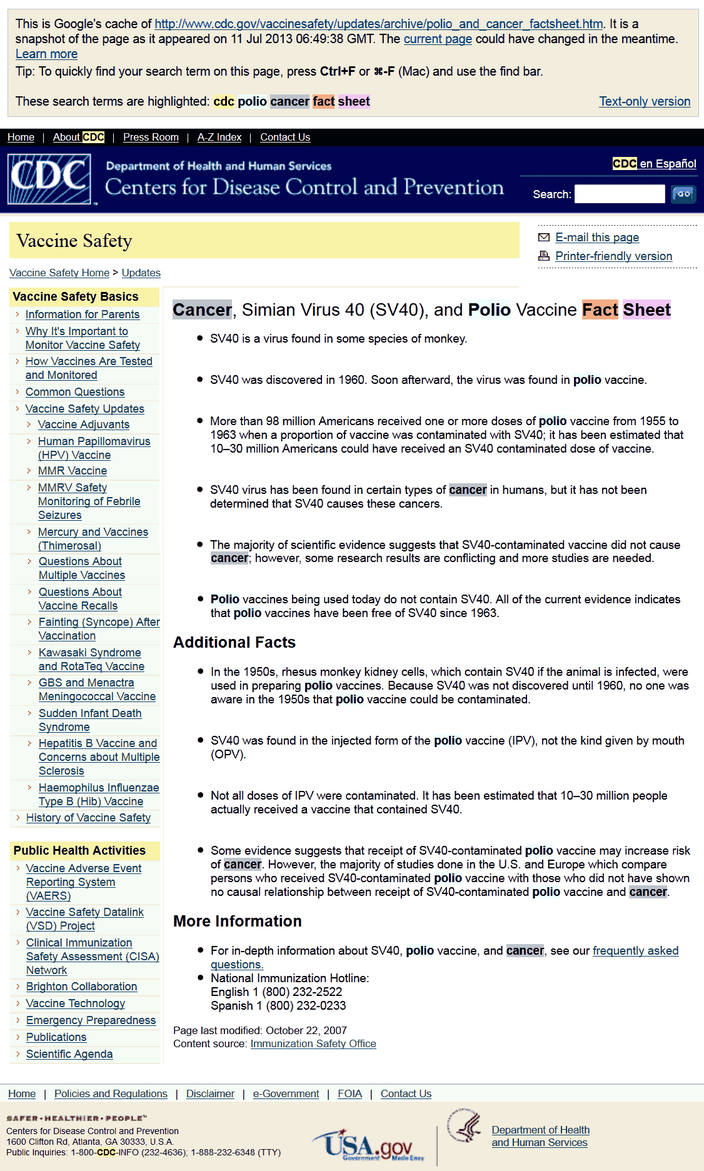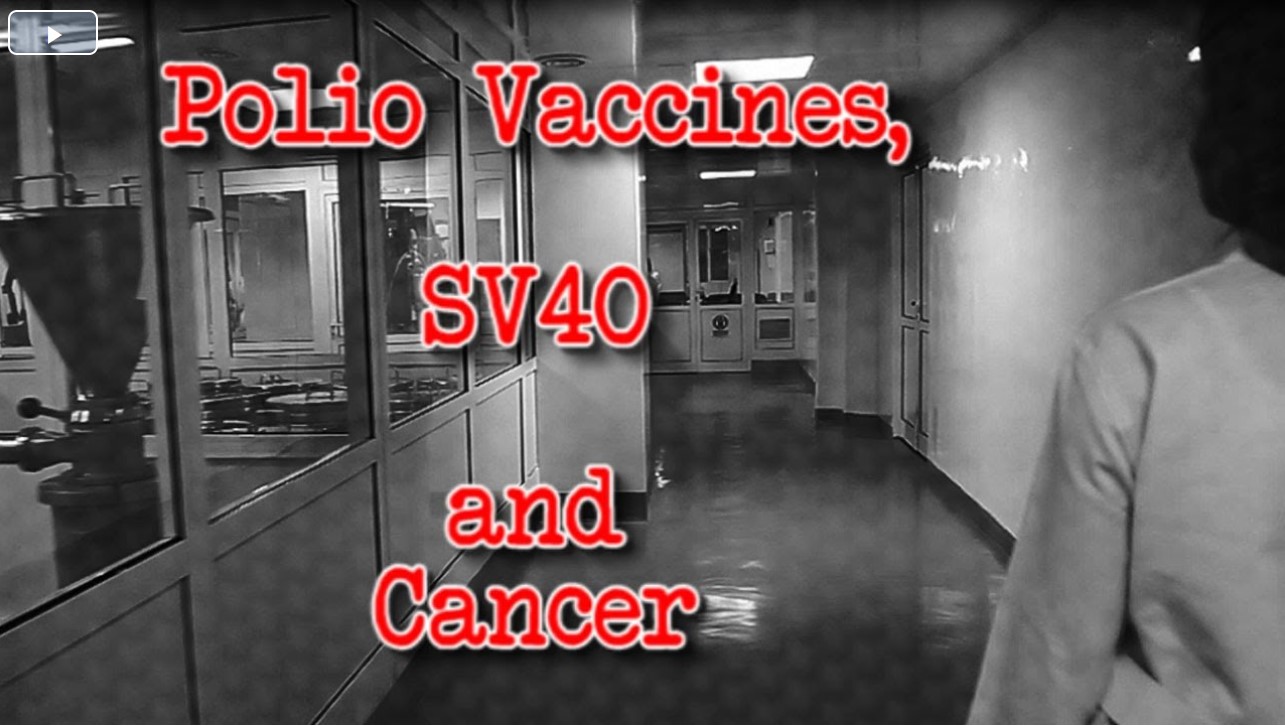15.07.2018
zuletzt geändert: 02.11.2023
SV40 – Affen-“Virus” im Polio-Impfstoff
SV40 als Impfschaden-Erreger, oder: Wie man Krebs und AIDS einimpft
61% der Tumore haben das SV40-“Virus” (ein Mix aus verschiedenen Eiweißen von Affen, meist aus Nieren-, Hoden- und Hautgewebe) eingekapselt, das um 1960 herum einige Jahre mit dem Polio-Impfstoff eingeimpft wurde:
“FACT: Before the Polio Vaccine, there had never been a virus from another species deliberately injected into humans.
FACT: 61% of all human tumors (at autopsy) now contain the SV40 monkey virus, traceable to the Polio vaccine of the 1950s and 60s.”
http://www.salem-news.com/articles/november292011/vaccines-contaminated-se.php
Das sog. Simian-Virus 40 oder Affen-Virus 40 von Affenzellen (Hoden, Haut, Nieren) befand sich in den ersten Polio-Impfstoffen von Dr. Jonas Salk (Inactivated Polio Vaccine, IPV) und von Dr. Albert Sabin (Oral oder “Live” Polio Vaccine, OPV).
Nebenbei gesagt ist das SV40-Virus in Wirklichkeit (wie alle behaupteten sog. krankmachenden “Viren”) ein normaler Zellbestandteil, ist aber als injiziertes Fremdeiweiß dennoch krankmachend und steht sogar in Verdacht, krebsauslösend zu sein. SV40 ist somit ein Impfschaden-Erreger.
SV40 steht nicht nur in Verdacht, für die ansteigende Krebsrate ab den 1960er Jahren verantwortlich zu sein, sondern auch Hauptauslöser für die Entstehung von AIDS und HIV ab 1975 zu sein. SV40 ist somit auch ein Epidemie-Erreger. Viele neue Krebsarten sowie AIDS und HIV sind darum in Wirklichkeit verheimlichte Impfschäden, deren Dunkelziffer offiziell auf 95% geschätzt wird, tatsächlich aber noch höher liegen dürfte.
In der heutigen Enkelgeneration findet man lt. Dr. Klaus Hartmann in Hirntumoren (Ependymome) von Kindern das SV40, das ihre Großeltern mit dem Polio-Impfstoff bekamen.
Der Impfschaden SV40 vererbt sich demnach weiter auf Kinder und Kindeskinder.
Detaillierte Informationen über SV40 findet man auf der Webseite der SV40 Foundation, die von Raphaele und Michael Horwin gegründet wurde im Andenken an ihren Sohn Alexander Horwin, der 1999 im Alter von 2,5 Jahren an einem Hirntumor verstarb mit positivem SV40-Nachweis.
Die Entstehung des oralen Polio-Impfstoffs aus schulmedizinischer Sicht
Typ I hat folgenden Stammbaum:
• 1941 isolierten Drs. Francis und Mack das Mahoney-Poliovirus “aus dem zusammengefaßten Kot von drei gesunden Kindern in Cleveland”. Dr. Salk unterzog den Stamm dann Passagen durch 14 lebende Affen und zwei Zellkulturen von Affenhoden.
• 1954 wurde der Stamm (jetzt Monk14 T2 genannt) Drs Li und Schaeffer übergeben, die das Virus neun weiteren Passagen durch Zellkulturen von Affenhoden unterzogen.
• Als nächstes unterzog man den Stamm (jetzt Monk14 T11 genannt) 15 weiteren Passagen in Kulturen von Affen-Hoden, 18 Passagen in Kulturen von Affennieren, zwei Passagen durch die Haut lebender Rhesusaffen und zusätzlichen Passagen durch Kulturen von der Haut von Grünmeerkatzen und wiederum von Affennieren. Dieser Stamm wurde MS10 T43 oder LS-c genannt.
• 1956 unterzog Dr. Sabin dieses Virus sieben Passagen durch Zellkulturen von Nierenzellen der afrikanischen Grünmeerkatze.
• Im selben Jahr Passagieren des Stammes (jetzt LS-c, 2ab / KP2 genannt) im Pharmaunternehmen Merck, Sharp & Dohme durch eine Zellkultur von Rhesusaffen-Nieren.
• Das Endmaterial wurde Sabin Original Merck (SOM) genannt und 1960 Lederle als Ausgangsmaterial zur Herstellung seines Polio-Impfstoffs zur Verfügung gestellt.
Die Typen II und III wurden auf ähnliche Weise erstellt.
– A.B. Sabin, A.B. & L. Boulger, History of Sabin Attenuated Poliovirus Oral Live Vaccine Strains. 1 J. BIOL. STAND. 115, 115–18 (1973), zit. n. SV40 Foundation.
Fotos: Grünmeerkatze (Pixabay CC0), SV-40-Virus, eingefärbte transmissionselektronenmikroskopische Aufnahme (Sabin/SV 40 Foundation op. cit.), Rhesusaffe, fair use.
29.10.2013: Krebsviren in Impfstoffen – kla.tv 1783
Wussten Sie, dass bereits in den 50er Jahren in Amerika verwendete Impfstoffe mit krebserregenden Viren (SV40-Viren) verseucht waren, die in Tierversuchen Tumore auslösten? Das geht aus einem Tonbandmitschnitt eines damaligen führenden Impfstoffentwicklers des Pharmariesen Merck hervor. Millionen Menschen sind damals im Zuge einer Polioimpfung mit diesem Virus in Berührung gekommen.
Trotz solch tragischer Vorkommnisse bleibt die Zusammensetzung zugelassener Impfstoffe als Betriebsgeheimnis allein den Herstellern bekannt. Wollen wir auf dieser Grundlage weiterhin bedingungslos der Propaganda Glauben schenken, dass eine Impfung uns tatsächlich vor Krankheiten schützt?
Anm. d. Red.: Die von der Schulmedizin propagierten Viren sind natürlich keine Viren, sondern normale Zellbestandteile, im Falle von SV40 aus Affennieren und aus Affenhaut. Als Fremdeiweiße machen sie aber trotzdem krank (Krebs, AIDS, sonstige Autoimmunschwäche usw.).
Entwickler von Merck-Impfstoff gibt zu, dass Impfstoffe regelmäßig verborgene Krebsviren kranker Affen enthalten
Mike Adams
Zitat: “Dass sich in Impfstoffen SV40-Krebsviren finden, ist keine Verschwörungstheorie: Das sagt ein führender Merck-Wissenschaftler, der sich vermutlich nicht träumen ließ, dass seine Tonaufnahme später einmal im Internet zu hören sein würde. Er dachte wahrscheinlich, sein Gespräch werde für immer geheim bleiben. Als er gefragt wurde, warum das nicht an die Presse gegeben werde, war seine Antwort: »Natürlich gehst du damit nicht an die Öffentlichkeit, es ist eine wissenschaftliche Angelegenheit unter Wissenschaftlern.«
Mit anderen Worten: Impfstoffwissenschaftler betreiben Vertuschung für Impfstoffwissenschaftler. Sie bewahren alle ihre schmutzigen Geheimnisse in ihren eigenen verschwiegenen Kreisen und halten die Wahrheit über die Verseuchung ihrer Impfstoffe zurück.”
Weiterlesen: Kopp Online, 12.09.2013 (offline), Waybackmachine (längere Ladezeit)
US-Gesundheitsbehörde gibt zu: 98 Millionen Amerikaner erhielten Polioimpfstoff, der mit krebsauslösendem Virus kontaminiert war
Ethan A. Huff
Zitat: “Wieder einmal wurde die US-Gesundheitsbehörde Centers for Disease Control and Prevention (CDC) dabei ertappt, dass sie wichtige, für sie belastende Informationen über Impfstoffe von ihrer Website entfernt hat. Dieses Mal betraf es den berüchtigten Polioimpfstoff.
Wie bekannt wurde, enthielten bis zu 98 Millionen Dosen ein krebsauslösendes Virus, das für Millionen von Krebserkrankungen in Amerika verantwortlich sein könnte, so die CDC.
Die Information wurde in offiziellen Daten und Fakten der CDC zum Thema »Krebs, Simianvirus 40 (SV40) und Polioimpfstoff« gepostet, die inzwischen von der CDC-Website gelöscht wurden.
Zum Glück hatte RealFarmacy.com die belastende Seite archiviert [dort auch nicht mehr, sie ist jetzt als pdf hier und in der Waybackmachine hier und hier], bevor die CDC sie entfernten – vermutlich deshalb, weil in jüngster Zeit wegen der Verbindung zu Krebs sehr viel über SV40 berichtet wurde.
Weiterlesen: Kopp Online vom 30.07.2013 (offline), Waybackmachine (längere Ladezeit)
A laughing Dr. Maurice Hilleman (Merck) admits adding cancer causing virus (SV40) to vaccine
The SV40 Virus: Has Tainted Polio Vaccine Caused An Increase in Cancer? / Excerpt: “The shocking story you are about to hear involves a pharmaceutical company which used monkeys to make polio vaccine, government health agencies responsible for making sure the vaccine was not contaminated with monkey viruses, and individuals who are now are dying from cancerous tumors that contain a monkey virus which appears to have contaminated that polio vaccine. At the heart of this tragic story is a violation of the public trust and the informed consent ethic. It is a story about what happens when the legal and moral duty for industry and government to insure that a vaccine will not harm individuals is sacrificed to insure acceptance and mass use of a vaccine by the entire population. It shows what can happen when Congress, which has oversight authority over federal health agencies, blindly trusts and fails to verify.”
Top-Wissenschaftler von Merck gibt zu, dass Polio-Impfstoffe Leukämie-, SV40- und Krebsviren enthielten
In diesem Interview aus dem Jahr 1987 gibt einer der prominentesten Impfstoffwissenschaftler in der Geschichte der Impfstoffindustrie, Dr. Maurice Hilleman, ein Merck-Wissenschaftler, offen zu, daß die an die US-Amerikaner verabreichten Impfstoffe mit Leukämie- und Krebs-“Viren” kontaminiert waren. Daraufhin brechen seine Kollegen (die hier ebenfalls aufgezeichnet sind) in Gelächter aus und finden das anscheinend urkomisch.
Dann schlagen sie vor, daß diese Impfstoffe, weil sie zuerst in Russland getestet werden, den USA helfen werden, die Olympischen Spiele zu gewinnen, weil die russischen Athleten alle “mit Tumoren belastet” sein werden (sie wussten also, dass diese Impfstoffe beim Menschen Krebs verursachen).
Dies ist keine Verschwörungstheorie – dies sind die Worte eines hochrangigen Merck-Wissenschaftlers, der wahrscheinlich nicht ahnte, dass es diese Aufnahme geben wird. Er dachte wahrscheinlich, daß sein Geständnis für immer ein Geheimnis bleiben würde.
Auf die Frage, warum dies nicht an die Presse gelangte, antwortete er: “Natürlich geht man nicht an die Öffentlichkeit, das ist eine wissenschaftliche Angelegenheit innerhalb der wissenschaftlichen Gemeinschaft.”
Mit anderen Worten: Impfstoff-Entwickler decken andere Impfstoff-Entwickler. Sie bewahren alle ihre schmutzigen Geheimnisse in ihrem eigenen Kreis des Verschweigens über die Wahrheit der von ihnen kontaminatierten Impfstoffe. Ein schockierendes Geständnis aus der Geschichte von 200 Jahren Impfbetrug und Fehlentwicklung der westlichen Hochschulmedizin.
Polio Vaccine Contaminated With Cancer Virus Received By 98 Million People Admits The CDC
CDC Admits 98 Million Americans Received Polio Vaccine Contaminated With Cancer Virus
The CDC has quickly removed a page from their website, which is now temporarily cached by Google, admitting that more than 98 million Americans received one or more doses of polio vaccine within an 8-year span when a proportion of the vaccine was contaminated with a cancer
causing polyomavirus called SV40. It has been estimated that 10-30 million Americans could have received an SV40 contaminated dose of the vaccine.
https://youtu.be/ypevotey62o
Vorlesung der Journalistin Sydney White: “‘Murder in the First! A History of Vaccines’ for Studies in Propaganda 2011 at the Free University of Toronto”
[“Mord! Geschichte der Impfstoffe”]
– Polio-“Virus” 41:25
– SV40 “Virus”, Affen mit Sabin Polio-Impfstoff getestet, bekamen alle Krebs.
1980er Jahre: Gallo: AIDS ist “Virus” dieser Affen 55:05
https://youtu.be/anSokq_uebM
Sydney White ist der Meinung, daß es sich bei diesen Impf-Skandalen um Vorsatz handelt, also Mord. Wir überlassen es dem Leser, diese moralische Frage für sich zu entscheiden, siehe auch die Seite Impfen = Mord?
Keerti V. Shah hat den geschichtlichen Verlauf der Verseuchung des Polio-Impfstoffs durch
das SV 40 nachverfolgt und auf die Gefahren hingewiesen, die mit Virus-Impfstoffen
einhergehen, die auf Primärzellen kultiviert werden:
„Die größte Übertragungsquelle an den Menschen war die Polio-Impfung, die allein in den Vereinigten Staaten 98 Millionen Individuen verabreicht wurde, und das zu einer Zeit, als ein Teil der Impfstoffe durch das Virus verseucht war. Formol, das verwendet wurde, um das Polio-
Virus zu inaktivieren, hat sich nicht als wirkungsvoll genug herausgestellt, um auch das SV 40 zu inaktivieren.”
– Aus: Fernand und Simone Delarue: Impfungen – der unglaubliche Irrtum.
Hinweis: In Wirklichkeit gibt es das Poliovirus natürlich genauso wenig wie alle anderen behaupteten angeblichen Viren, die nur Laborkonstrukte sind. Darum kann man sie auch nicht inaktivieren. Sie sind als Fremdweiweiße natürlich nicht minder schädlich und führen zu Abstoßungsreaktionen und Hirnentzündungen und im Falle des SV40 offenbar zu erhöhter Krebsrate und Immunschwäche.
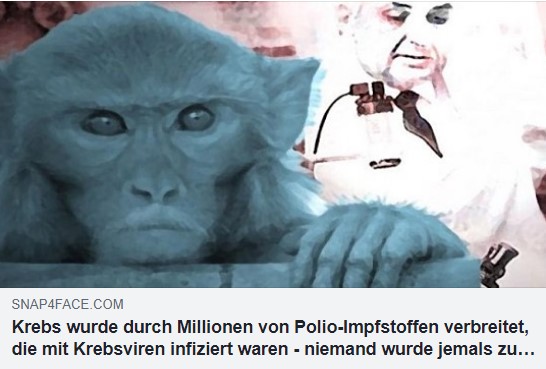
Sep 16, 2014: What the CDC Won’t Tell You About SV40, Polio Vaccines and Cancer
Link to CDC’s old FAQ website on SV40 virus and Polio vaccines: http://web.archive.org/web/20120503021608/http://www.cdc.gov/vaccinesafety/updates/archive/polio_and_cancer.htm
(Truthstream Media.com) The public was kept in the dark for decades about tens of millions of polio vaccines laced with SV40, and its implications for the widespread epidemic of cancer.
The relevant facts were known by the scientific community back in 1960, but it wasn’t until lawsuits and investigative reports in the 1990s and a Congressional hearing in 2003 that the public was informed about the scale of the contamination and its possible link to many of the deadly forms of cancer spreading today. Yet little has been acknowledged in public discussion since that point.
In the aftermath of these admissions and inquiries, the CDC launched a fact sheet page on its website addressing the links between “Cancer, Simian Virus 40 (SV40), and Polio Vaccine” which noted the discovery of SV40, its presence in an estimated 10-30 million doses of polio vaccine and disputed scientific claims concerning its presence in cancer tumors and its possible role in causation.
Worse, scientists in the late 1990s revealed a secondary form of SV40 that was present in post-1963 versions of the polio vaccines — after the formulations with SV40 were replaced — which were not detectable in the testing methods used up until that point — meaning that the impact of this virus on the public could be even more widespread yet largely unknown.
But as of June 2013, that CDC page has been apparently scrubbed and is no longer available, except through a cached version shown in this video. Do they expect the public to forget?
Regardless, nothing has been done to hold any of the pharmaceutical giants responsible for this monstrosity liable for their actions, and the companies continue to produce vaccines administered to Americans every single day.
Whatever master agenda could be at work here, it is amazing that the American and global public continue to trust their bodies to the same science that ‘accidentally’ contaminated tens of millions of people vaccinated for polio with a monkey virus found time and again in cancerous tumors. The presence of SV40 — which Merck vaccine scientist Maurice Hilleman joked in the video below caused tumors — has not officially been recognized by the government as having caused all these cancers (again, the CDC has continued to affirm ‘further research is needed’).
As this strain of monkey virus has consistently been found present in many types of cancerous cells in people all over the world at this point, the significance of such a correlation cannot be denied.
Why are the same industry and government players allowed to continue to play both God and doctor on your children? On your family, neighbors and fellow human beings? Why has no one been held accountable for these crimes of negligence, or worse?
Simian Virus 40 (SV40): A Cancer Causing Monkey Virus from FDA-Approved Vaccines
Michael E. Horwin, M.A., J.D.*
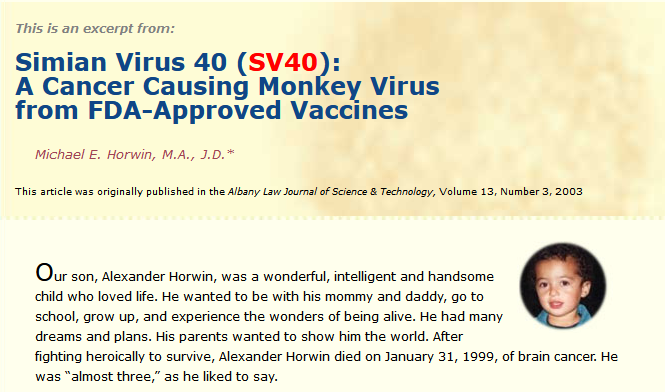
This article was originally published in the Albany Law Journal of Science & Technology, Volume 13, Number 3, 200
Our son, Alexander Horwin, was a wonderful, intelligent and handsome child who loved life. He wanted to be with his mommy and daddy, go to school, grow up, and experience the wonders of being alive. He had many dreams and plans. His parents wanted to show him the world. After fighting heroically to survive, Alexander Horwin died on January 31, 1999, of brain cancer. He was “almost three,” as he liked to say.
Polio-Impfstoff über Jahrzehnte verseucht
Zitat: “Mediziner aus den USA warnen vor den möglichen Spätfolgen der Impfung gegen Kinderlähmung. Bis in die achtziger Jahre enthielt ein sowjetisches Impfserum einen Affenvirus, der Krebs auslösen kann. Der Impfstoff wurde millionenfach im gesamten Ostblock sowie in China und Japan verabreicht.”
– Der Spiegel vom 08.07.2004
As the world races to fast-track a COVID-19 vaccine, bringing an experimental shot to market faster than has ever occurred in history, the potential risks of medical procedures like vaccination must be carefully weighed. Unintended harms can and do occur following vaccination, and the inactivated and live polio vaccines are prime examples.
From 1955 to 1963, hundreds of millions of people worldwide — in North and South America, Canada, Europe, Asia and Africa — received polio vaccines that may have been contaminated with simian virus 40 (SV40), a monkey virus.1 The video above is a decade old, but it succinctly summarizes the serious consequences that can occur from vaccine contamination — consequences that may not be realized until many years later.
In the video, Dr. John Bergsagel, then a pediatric oncologist, looks at laboratory slides of tumors taken from children who died of extremely rare brain cancers. When SV40-like DNA sequences were detected in them, he said, “I almost fell out of my chair. I was very surprised.”
The finding, published in The New England Journal of Medicine in 1992, revealed that half the choroid plexus tumors and most of the ependymomas studied contained a segment of T-antigen gene related to SV40.
“These results suggest that SV40 or a closely related virus may have an etiologic role in the development of these neoplasms during childhood,” they wrote2 — and this was only the beginning of findings linking monkey virus-contaminated polio vaccines to cancer.
How a Monkey Virus Ended up in Polio Vaccines
During the 1950s, the inactivated polio vaccine created by Jonas Salk was made using rhesus monkeys that were infected with SV40. As explained in a 2004 perspective published in The Lancet:3
“When Salk developed his vaccine, instead of using human tissues, as did the scientists who won a Nobel Prize for first growing poliovirus in tissue culture, he used minced-up rhesus macaque monkey kidneys, which were remarkably efficient poliovirus factories.
Those who sought to supplant Salk’s formaldehyde-inactivated vaccine with live, attenuated oral vaccine also used monkey kidney cultures. Despite a manufacturing problem that, at best, left six children who received the vaccine paralyzed in the arm, and despite concerns about wild simian viruses, Salk’s shots were declared safe and effective after 1954 field trials.
The next year, after grudging approval by skeptical government regulators, free Salk shots were made available throughout the USA. By 1960, scientists and vaccine manufacturers knew that monkey kidneys were sewers of simian viruses.”
The late Bernice Eddy, a researcher at the National Institutes of Health, conducted a study in 1959, injecting hamsters with the rhesus monkey kidney substrate used to make the vaccines. The majority of them developed tumors.4
“Eddy’s superiors tried to keep the discovery quiet, but Eddy presented her data at a cancer conference in New York. She was eventually demoted, and lost her laboratory,” The Atlantic reported,5 but soon after researchers with Merck pharmaceutical company identified the cancer-causing virus in rhesus monkey kidney cells, naming it SV406 because it was the 40th monkey virus discovered.
According to Barbara Loe Fisher, co-founder and president of the National Vaccine Information Center (NVIC), in a presentation before the U.S. House of Representatives in 2003:7
“Sadly, the American people were not told the truth about this in 1960. The SV40 contaminated stocks of Salk polio vaccine were never withdrawn from the market but continued to be given to American children until early 1963 with full knowledge of federal health agencies.
Between 1955 and early 1963, nearly 100 million American children had been given polio vaccine contaminated with the monkey virus, SV40.”
SV40’s Cancer Link
In animal studies, SV40 has been linked to a number of cancers, including mesotheliomas, lymphomas, brain and bone tumors and sarcomas.8 Such tumors in humans have also been found to contain SV40 DNA and proteins. Brain tumors and mesotheliomas appear to be the most common tumors associated with SV40, with some studies showing a positivity rate of up to 60%.
While there wasn’t an “epidemic” of cancers that followed the widespread administration of vaccines contaminated with SV40, which suggests the virus alone may not be causing the cancers, researchers noted, “it seems possible that SV40 may act as a cofactor in the pathogenesis of some tumors.”9
As further reported in Oncogene, at least three independent scientific panels agreed “there is compelling evidence that SV40 is present in some human cancers and that SV40 could contribute to the pathogenesis of some of them.”10
It was also revealed that, in Finland where no SV40-contaminated polio vaccine was used, researchers did not find any SV40-like DNA in frozen tumor tissues from Finnish mesothelioma patients.
The results suggest that the SV40-like DNA sequences detected in other mesothelioma tissue did come from contaminated polio vaccines, though, “It is a matter of speculation whether the absence of SV40 infection has contributed to the relatively low incidence of mesothelioma in Finland.”11
In 2002, meanwhile, The Lancet published evidence showing SV40 is significantly associated with some types of Non-Hodgkin lymphoma after detecting it in 42% of Non-Hodgkin lymphomas tested.12 And in a 2004 review of the then-available evidence, it’s noted:13
“Persuasive evidence now indicates that SV40 is causing infections in humans today and represents an emerging pathogen.
A meta-analysis of molecular, pathological, and clinical data from 1,793 cancer patients indicates that there is a significant excess risk of SV40 associated with human primary brain cancers, primary bone cancers, malignant mesothelioma, and non-Hodgkin’s lymphoma.”
It’s often claimed via the media and even by some prominent health organizations that the link between SV40 from vaccines and cancer has been debunked as a myth, but in 2002 the Institute of Medicine released a report that found “evidence is inadequate to accept or reject a causal relationship between SV40-containing polio vaccines and cancer,” adding:14
“… biological evidence is of moderate strength that SV40 exposure could lead to cancer in humans under natural conditions … biological evidence is of moderate strength that SV40 exposure from the polio vaccine is related to SV40 infection in humans.”
Is SV40 Spreading Through Human Populations?
Controversy still remains over the SV40-contamianted vaccines, including whether the monkey virus is still spreading among humans. There is evidence, for starters, that SV40-contaminated live oral polio vaccines (OPV) continued to be used for many years after SV40 contamination was discovered, including until 1978 in the former USSR and until 1999 in Italy.15
In fact, in 2005 researchers with Loyola University in Chicago conducted a study to test for SV40 in OPV prepared after 1961. They tested vaccine samples from 13 countries, revealing that OPV from “a major eastern European manufacturer” produced from the early 1960s to about 1978 contained infectious SV40:16
“Our findings underscore the potential risks of using primary monkey cells for preparing poliovirus vaccines, because of the possible contamination with SV40 or other monkey viruses, and emphasize the importance of using well-characterized cell substrates that are free from adventitious agents.
Moreover, our results indicate possible geographic differences in SV40 exposure and offer a possible explanation for the different percentage of SV40-positive tumors detected in some laboratories.”
Once exposed to the SV40 virus via a contaminated vaccine, it’s also possible that it has spread among humans via other methods. The monkey virus was found to spread for weeks in children’s stools following vaccination with SV40-contaminated vaccines, for instance,17 which suggests SV40 may replicate in gastrointestinal cells and could be spread via a fecal-oral route.
DNA sequences from SV40 have been found in a wide range of tissues among those vaccinated with SV40-contaminated vaccine, including pituitary tissues and leukocytes from organ and blood donors, as well as blood samples. “These data cumulatively demonstrate that SV40 is circulating in the human population,” researchers wrote in Frontiers in Oncology.18

